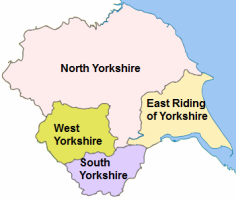View Larger Map
Map of Yorkshire | Local Search for Attractions & Services
Use the interactive tourist map of Yorkshire to search for a range of local attractions, services and amenities. The county of Yorkshire is divided into North, South West and East Riding of Yorkshire, located in northern England, the large area covered by the various counties offer a range of scenery, landscapes and a mix of town and country. The area includes a number of open spaces and landscapes including the Yorkshire Dales and North York Moors National Parks.
The area includes plenty scenic countryside, coastline and along with a number of scenic small towns and villages. There are a number of historic houses, museums, gardens and attractions including York Minster, Fountains Abbey & Studley Royal Park, a world heritage site and the Forest of Bowland – area of outstanding natural beauty. The county includes a number of attractions for visitors to explore, including a range of historic and family attractions.
Search for Yorkshire restaurants, cafes, coffee shops, bars, tourist information, visitor attractions including museums, art galleries, historic houses, cinemas, theatres, places of interest and much more. Use the map to better plan your trip to Yorkshire using the useful interactive tourist map, learn more about the county and the range of tourist attractions the counties in Yorkshire have to offer.
The map includes a location and area map of Yorkshire along with street view. Use the map to:
- Find directions for driving, walking, bicycling and public transport.
- Use the search function to find local attractions, dining, entertainment, services and amenities.
- Use the layers on the map to find information on local weather and forecast, travel information including traffic conditions showing the latest traffic flow and congestion.
- The photos layer includes photos relating to the map area from panoramio.
- The Distance tool shows a distance radius around a point on the map and can be used to calculate the distance between two points on the map.
Notable local attractions in Yorkshire include: North York Moors, Forest of Bowland (AONB), Ripley Castle, Castle Howard, Fountains Abbey & Studley Royal Park, a UNESCO World Heritage Site, Harewood House, Mother Shipton’s Cave, RHS Garden Harlow Carr, Flamingo Land and York Minster.
Local cities and towns in Yorkshire include: City of Leeds, City of York, Harrogate, Sheffield, Bradford, Skipton, Halifax, Huddersfield, Rotherham and Kingston-upon-Hull.
English Counties sharing a border with Yorkshire include:
North Yorkshire: County Durham, Cumbria, East Riding of Yorkshire, Lancashire, South Yorkshire and West Yorkshire.
South Yorkshire: Derbyshire, East Riding of Yorkshire, Lincolnshire, North Yorkshire, Nottinghamshire and West Yorkshire.
West Yorkshire: Derbyshire, Greater Manchester, Lancashire, North Yorkshire and South Yorkshire
East Riding of Yorkshire: Lincolnshire, North Yorkshire and South Yorkshire.
To view the interactive Yorkshire maps please see: Map of Yorkshire - Local Search Map
Disclaimer: The information given in on this website is given in good faith and to the best of our knowledge. If there are any discrepancies in no way do we intend to mislead. Important travel details and arrangements should be confirmed and verified with the relevant authorities.


